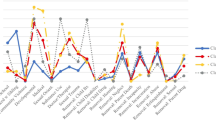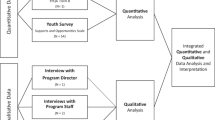Abstract
Previous research indicates that runaway and homeless youth often achieve positive outcomes after shelter stays however few studies have examined how these outcomes are achieved. This study employs qualitative methods to explicate this phenomenon. Twenty-five providers and 21 youth from four shelters participated in this study. Youth were recruited who had completed shelter care and returned home for minimally six months. Multiple raters identified themes and created a conceptual model. While in shelter, youths experienced structure and freedom, and the family experienced respite. Once youth became involved in treatment, the family re-connected and the youth returned home. After returning home, youth and family become involved in follow-up services. Results from our study provide insight into the process through which runaway/homeless youth return home after a shelter stay. Our findings emphasize the need for continued change by all members of the family system, highlighting the need for continued intervention to maintain positive changes.
Similar content being viewed by others
References
Bass, M. J. (1992). Assessing functional status in family practice. Family Medicine, 24, 134.
Greene, J. M., Ringwalt, C. L., & Iachan, R. (1997). Shelters for runaway and homeless youths: Capacity and Occupancy. Child Welfare, 76, 549–561.
Kurtz, P., Jarvis, S. & Kurtz, G (1991). Problems of maltreated runaway youth. Adolescence, 26, 544–555.
McMorris, B. J., Tyler, K. A., Whitbeck, L. B., & Hoyt, D. R. (2002). Familial and on-the-street risk factors associated with alcohol use among homeless and runaway adolescents. Journal of Studies on Alcohol, 63, 34–43.
North, C. S., Pollio, D. E., Megivern, D., Pfefferbaum, B., Vythilingam, M., Westerhaus, E. T., Martin, G., Hong, B. (in press). Experience of Bioterrorism on Capitol Hill: Qualitative Findings from Focus Groups. Journal of Traumatic Stress.
Pollio, D. E., & Kasden, A. (1996). Walking around with a question mark on your head: Social and personal constructs among persons on the streets. Journal of Applied Social Science, 20, 107–119.
Ringwalt, C. L., Greene, J. M., & Robertson, M. J. (1998). Family backgrounds and risk behaviors of youth with thrownaway experiences. Journal of Adolescence, 21, 241–252.
Rotheram-Borus, M. J. (1993). Suicidal behavior and risk factors among runaway youths. American Journal of Psychiatry, 150, 103–107.
Safyer, A. E., Thompson, S. J., Maccio, E., Zittel-Palamara, K., & Forehand, G. (2004). Adolescent and parent perceptions of runaway behavior: Problems and solutions. Child and Adolescent Social Work Journal, 21, 493–510.
Teare, J. F., Furst, D., Peterson, R. W., & Authier, K. (1992). Family reunification following shelter placement: child, family, and program correlates. American Journal of Orthopsychiatry, 62, 142–146.
Thompson, S. J., Kost, K. A., & Pollio, D. E. (2003). Examining risk factors associated with family reunification for runaway youth: Does ethnicity matter? Family Relations, 52, 296–304.
Thompson, S. J., Pollio, D. E., Constantine, J., Reid, D., & Nebbitt, V. (2002). Short-term outcomes for youth receiving runaway homeless shelter services. Research on Social Work Practice, 12, 589–603.
Thompson, S. J., Safyer, A., & Pollio, D. E. (2001). Runaway/Homeless Youth and Family Reunification. Social Work Research, 25, 163–172.
Thompson, S. J., Pollio, D. E., & Bitner, L. (2000). Outcomes for adolescents using runaway and homeless youth services. Journal of Human Behavior and Social Environment, 3, 79–97.
Tyler, K. A., Hoyt, D. R., Whitbeck, L. B., & Cauce, A. M. (2001). The impact of childhood sexual abuse on later sexual victimization among runaway youth. Journal of Research on Adolescence, 11, 151–176.
Whitbeck, L. B., Hoyt, D. R., & Wa-Ning, B. (2000). Depressive symptoms and co-occurring depressive symptoms, substance abuse, and conduct problems among runaway and homeless adolescents. Child Development, 71, 721–732.
Whitbeck, L., Hoyt, D., & Ackley, K. (1997). Families of homeless and runaway adolescents: A comparison of parent/caretaker and adolescent perspectives on parenting, family violence, and adolescent conduct. Child Abuse and Neglect, 21, 517–528.
Acknowledgments
The authors thank the participant agencies in the MINK (Missouri, Iowa, Nebraska, Kansas) Network, Federal Region VII. They also acknowledge the ongoing support of Linda Bitner at ACF, and James Braun, CEO of Youth-In-Need.
Author information
Authors and Affiliations
Corresponding author
Rights and permissions
About this article
Cite this article
Nebbitt, V.E., House, L.E., Thompson, S.J. et al. Successful Transitions of Runaway/Homeless Youth from Shelter Care. J Child Fam Stud 16, 545–555 (2007). https://doi.org/10.1007/s10826-006-9105-2
Published:
Issue Date:
DOI: https://doi.org/10.1007/s10826-006-9105-2




